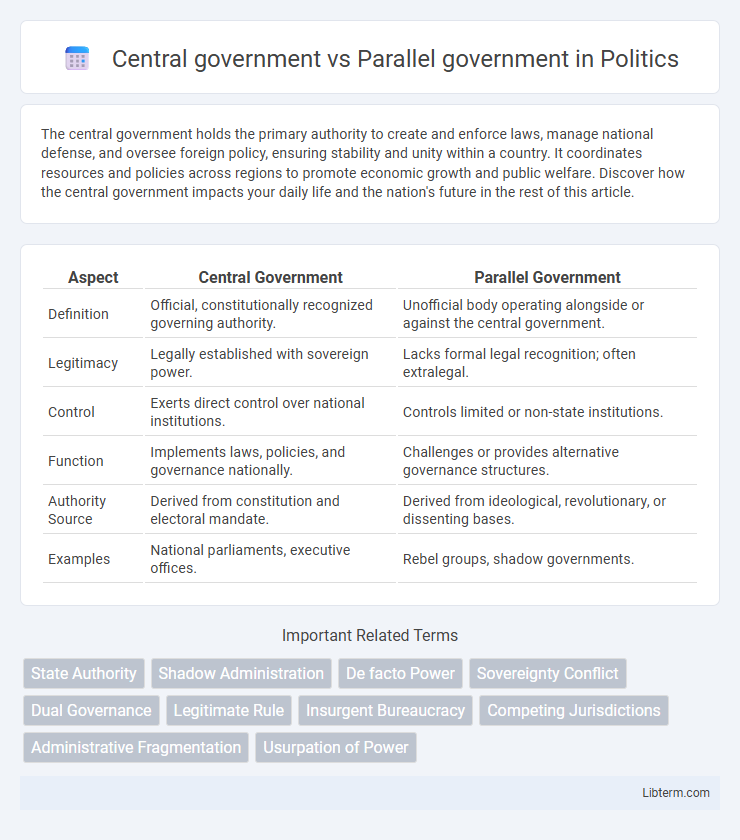The central government holds the primary authority to create and enforce laws, manage national defense, and oversee foreign policy, ensuring stability and unity within a country. It coordinates resources and policies across regions to promote economic growth and public welfare. Discover how the central government impacts your daily life and the nation's future in the rest of this article.
Table of Comparison
| Aspect | Central Government | Parallel Government |
|---|---|---|
| Definition | Official, constitutionally recognized governing authority. | Unofficial body operating alongside or against the central government. |
| Legitimacy | Legally established with sovereign power. | Lacks formal legal recognition; often extralegal. |
| Control | Exerts direct control over national institutions. | Controls limited or non-state institutions. |
| Function | Implements laws, policies, and governance nationally. | Challenges or provides alternative governance structures. |
| Authority Source | Derived from constitution and electoral mandate. | Derived from ideological, revolutionary, or dissenting bases. |
| Examples | National parliaments, executive offices. | Rebel groups, shadow governments. |
Understanding Central Government: Definition and Roles
The Central Government is the primary authority responsible for national governance, law-making, and policy implementation across an entire country. It holds executive, legislative, and judicial powers that unify regional administrations and maintain overall stability. Central governments oversee defense, foreign relations, and economic policies critical to national development and security.
What is a Parallel Government? Key Characteristics
A Parallel Government refers to a system operating alongside the official central government, often established by groups or communities seeking autonomy or resistance against existing authority. Key characteristics include a separate administrative structure, independent law enforcement, and parallel social services that function without formal recognition. These entities frequently emerge during political instability, aiming to provide governance and legitimacy alternative to the central government.
Historical Examples of Parallel Governments
Parallel governments emerged in history as alternative administrative structures challenging central authorities, notably during the Indian independence movement where the Indian National Congress established parallel governments in regions like Satara and Tamluk to undermine British rule. These parallel administrations managed local governance, law enforcement, and public services, effectively creating autonomous zones that operated independently of the colonial central government. Such historical examples highlight the strategic role of parallel governments in resisting centralized control and asserting political sovereignty.
Constitutional Framework Governing Central Authority
The constitutional framework governing central authority establishes a unified sovereignty with supreme legislative, executive, and judicial powers concentrated in the central government, ensuring consistent national governance and uniformity in law enforcement. Parallel governments, lacking constitutional recognition, operate outside this legal framework, often leading to conflict and challenges in legitimacy, as they do not possess lawful authority sanctioned by the constitution. Central government legitimacy is derived from constitutional provisions that delineate jurisdiction and empower institutions to function within the bounds of national sovereignty and constitutional supremacy.
Causes Behind the Emergence of Parallel Governments
The emergence of parallel governments often stems from political instability, weak central authority, and widespread distrust in official institutions, leading various groups to establish alternative governance structures to assert control and legitimacy. Ethnic, religious, or ideological divisions within a country exacerbate these tensions, prompting marginalized communities or factions to create parallel administrations as a means of securing representation and resources. Economic disparities and ineffective governance further fuel the rise of rival governments, as local populations seek security and services that the central government fails to provide.
Central Government vs Parallel Government: Power Dynamics
Central government wields supreme authority over national policies, defense, and international relations, consolidating power within a legally recognized framework. Parallel governments emerge as alternative power structures challenging the central authority by establishing independent administrative control, often in conflict zones or regions with separatist tendencies. The power dynamics between central and parallel governments hinge on legitimacy, control over resources, and the ability to mobilize support from local populations and external actors.
Impacts on Governance and Public Administration
Central government consolidates authority, ensuring uniform policies and streamlined decision-making across the entire nation, which enhances national unity and policy coherence. Parallel government structures, operating concurrently or in opposition, often fragment administrative control, leading to conflicting regulations and inefficiencies in public service delivery. This division undermines governance by creating ambiguity in accountability, reducing institutional effectiveness, and complicating resource allocation.
Legal Implications and Challenges
The central government holds supreme legal authority defined by the constitution, whereas a parallel government operates without constitutional legitimacy, leading to complex challenges in sovereignty and law enforcement. Legal implications include jurisdiction conflicts, undermining rule of law, and potential criminal liability for parallel government actors. Challenges encompass maintaining public order, ensuring constitutional supremacy, and preventing legal ambiguity in administrative and judicial processes.
Managing Conflicts: Central Government Responses
Central governments manage conflicts through authoritative legal frameworks, deploying law enforcement and military forces to maintain order and assert sovereignty. Strategies include negotiation, enforcement of constitutional laws, and sometimes political reforms aimed at integrating dissenting groups. These responses are designed to uphold national unity while addressing localized unrest or parallel government claims.
The Future of Governance: Lessons and Recommendations
Central government structures emphasize unified authority and policy coherence, while parallel governments operate those with decentralized, autonomous systems that foster localized decision-making and innovation. Lessons for the future of governance include balancing centralized control with regional autonomy to enhance responsiveness and accountability, supported by technological integration for transparent and efficient public administration. Recommendations advocate for adaptive governance frameworks that leverage digital platforms, promote inclusive participation, and ensure equitable resource distribution across diverse jurisdictions.
Central government Infographic

 libterm.com
libterm.com